Though Heman Chong: This is a dynamic list and may never be able to satisfy particular standards for completeness may be a hell of a title to say out loud, boy does it fit this acerbic artist well.
A key figure in Singapore’s art history, Chong epitomises a generation of regional artists who found international acclaim as contemporary artists at the turn of the century and the dawn of our hyper-networked digital age.
His multifaceted artist practice defies easy categorisation and fluidly moves between photography, installation, performance, and painting–yet somehow, the Singapore Art Museum (SAM) has managed to do just that.
From 10 May to 17 August 2025, explore 51 works from the early 2000s to the present, including six new commissions unveiled at the exhibit, each playing their part in building an overall map of Chong’s prolific conceptual practice, all the while inviting fresh perspectives on its meaning and relevance today.
And speaking of fresh, here’s something new I’m going to do for this especially special exhibit: across all nine parts of Herman’s first major survey, I’m going to give you our favourite artworks from each of them, complete with our reasoning on why they stood out to boot.
So, from “The Singapore Flag” to a slip-and-slide made from the enemies of you and me, here are my top picks for Heman Chong: This is a dynamic list and may never be able to satisfy particular standards for completeness! (Man, this tagline will never escape me…)
Part 1: Words
We start at the first part, titled Words, which the exhibition describes as “the building blocks of narratives.” Here, my personal highlight is one that most might miss–an artwork presented in banner form right above the exhibit’s entrance, and also one that conveniently lets me segue into explaining the long string of words you’ve been reading!
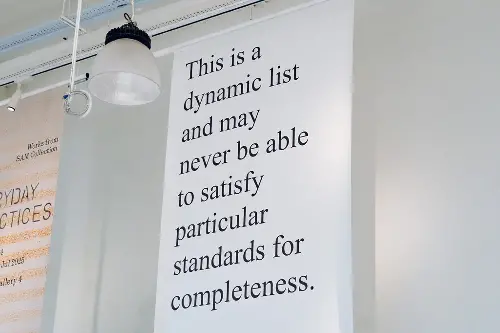
The title of this exhibition is appropriated from a disclaimer for dynamic lists on Wikipedia. An indemnity as much as a decoration, its application has the caveat that this is neither a comprehensive survey of the artist’s practice, nor his final show and art form.
The legalese of this disclaimer and its origins from “the free online encyclopedia” also point to the legal system and the information-saturated digital world Chong has to constantly navigate through as an artist, both recurring themes we’ll no doubt continue to see throughout the parts.
Indeed, while it isn’t the most colourful of pieces, I nevertheless found its meaning to be most vibrant in this first part.
Part 2: Whispers
Next, we move on to Whispers…”Of secrets and hiding in plain sight.” For what is technically the first room of the exhibition, it’s so embarrassing for me to say that I’m already struggling to choose!
Initially, I decided upon Index (Down) because it consisted of an impressively high 9,600 self-adhesive stickers applied directly onto a wall, reflecting the market’s unpremeditated and seemingly free fluctuations. But after it reminded me too much of my investment portfolio, I reluctantly turned against it.
Then, I set my mind on Paperwork–a sculpture consisting of 500 rusted iron sheets cut to A4 size. Its inspiration dates all the way back to Heman’s days as a fresh graphic designer, when he grew to question and despise the standard format of paper, so much so that he likened its genericness to “eating McDonald’s.” But once again, I found myself searching for something more—because without that intriguing backstory (which, by the way, isn’t even included in the exhibit’s notes), it’s quite literally just 500 rusted A4-sized iron sheets.
I thought for a long, long while, until finally, I settled on Simple Sabotage. This towering wall print of the Office of Strategic Services’—aka the CIA’s World War II predecessor—Simple Sabotage Field Manual was super interesting to read up close, and honestly? I think I would fall for most of these maliciously compliant tactics.
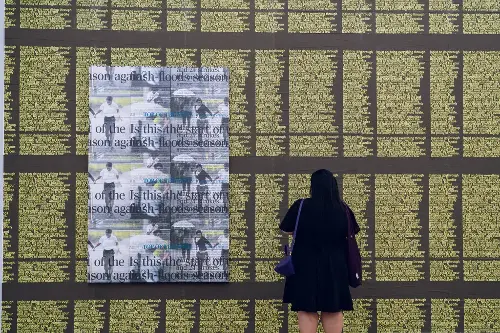
From covert steps of subterfuge like “Be worried about the propriety of any decision” to outright blatantly disruptive ones like “Bring up irrelevant issues as frequently as possible,” it really does make one wonder: the CIA wasn’t the nicest of agencies, huh? And also, if this is what the American government is comfortable declassifying–what exactly do they still not dare to publicise?
Well, no matter what it is, we’ll both probably be long gone in the afterlife when it leaks, bringing us nicely into the next part of the exhibition.
Part 3: Ghosts
“Traces that linger, resisting endings and erasure.” This is the description of Ghosts, and it’s not exactly hard to tell why. Every work here has something missing. Yet, nothing here is truly gone. Though the bodies of these original pieces may be cut up, mutilated, and covered, the spirit of their mediums remains, and nothing shows that better than Secrets and Lies (The Impossibility of Reconstitutions).

Comprising 326 spy and espionage novels shredded by the artist, the work’s deconstructed form—reduced to individual lines of text—is not intended as an act of destruction. Instead, it’s a rearrangement of meaning that reflects the undercover and cryptic nature of their original narratives, inviting visitors to piece together their own stories through a mix-and-match of strips.
And when I meant piece together, I really mean piece together! Visitors are encouraged to touch and interact with the mountains of shreds as part of the exhibit experience. In fact, I had to resist the urge to jump into these bales of fibre! But then again, thinking about the sort of paper cuts lurking inside–maybe that’s for the better.
Part 4: Journeys
But oh, what a coincidence! Just when we’re about halfway through our journey, we encounter a part that’s also named…Journeys! Funny how life works like that. Anyway, this room focuses on the “Passages of time, narrative, landscape and flights of fancy,” and while each work here certainly carries a piece of that, no better destination inside this room that truly encapsulates the full spirit of those words quite like Perimeter Walk.

Made of 550 postcards that feature photographs taken by Chong as he walked around the circumference of Singapore, Perimeter Walk captures the scenography of the island’s edges–be they familiar or not.
From images of sand walls and signs of border surveillance to workers resting by the roadside and lush vegetation, this collection brashly contrasts with the usual slick, idealised branding of the city-state, offering instead a more natural look at the coasts of our Little Red Dot beyond just Marina Bay Sands and the Merlion.
Also, if you’re game for a Where’s Waldo-style challenge, try spotting the cat that appears in the exhibit’s posters in this work as well! No prizes from me or DANAMIC if you do–but just like every other postcard in this collection, you’re more than welcome to participate in the circulation and consumption of these images by purchasing a picture or two of that little furball to keep and share with others!
Part 5: Futures
“The future is a construct and a horizon.” That’s alright and dandy for me, but now my only question then is–between the works featured in Futures, which is which?
Presumably, 106B Depot Road Singapore 102106 is the construct, since it’s a 3D print of the artist’s home and studio (am I doxxing him right now?), based not on the HDB block’s architectural plans but rather his memory and description of it. Moreover, Foreign Affairs—a series of photos depicting banal back doors to embassies encountered by Chong during his travels—doesn’t seem to fit the bill for either.
Which means, the horizon must then be Calendars (2020–2096). And seeing as seven decades of the future are plastered all about me, that seems quite fitting.

Presenting 1,001 photographs (not Dalmatians!) captured in Singapore between 2004 and 2010 and arranged across 912 months of calendar entries, the artwork projects these paradoxically emptied images of public spaces into the unknowable reaches of the time ahead. Its chronological order and design recall the strategies of 1960s conceptual art in representing time through grid and repetition.

Plus, being devoid of human presence and activity, the work seems just as much reminiscent of the recent COVID lockdowns as it does of an eerily dystopian future. Oh well, que sera, sera!
Part 6: Findings
Now, what have we found here? At Findings, a place “Of research and discoveries, simply found everyday,” there are a lot of knick-knacks to be explored. So, in continuing the themes of state identity and sovereignty that we barely touched upon in the previous part with Foreign Affairs, here’s my favourite—and arguably, the cheekiest—of the bunch: The Singapore Flag.
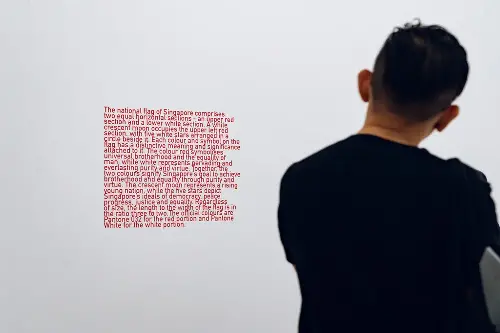
As with all other national flags, The Singapore Flag is a symbol of statehood that represents the ideals, beliefs, and values of the nation. But as with all other national flags, the concept of a national identity in it is wholly dependent on who’s looking.
Here in text form, the artwork reproduces an official description of the flag—lifted directly from the National Heritage Board’s website—and renders it in the exact shade of red prescribed, illustrating how the flag can be imagined rather than seen. Some may hate how this managed to get exhibited under a museum–but honestly, this piece is exactly why I love conceptual art!
Part 7: Infrastructures
Unfortunately, there’s no image for this room, and that’s because it’s all video! While historically and etymologically referring to what enables military movement, Infrastructures today applies to everything from state projects and laws to networks and technology–speaking to the superstructure of everyday systems that define and shape the world.
As such, the room’s only work, Modernity and Beyond, began as videos created as part of Heman’s ongoing Ambient Walking YouTube channel, in which he records videos while—you guessed it—walking.
The two videos presented, each running for over an hour, were made in 2020 within the SAM’s former premises on Bras Basah Road at the St. Joseph’s Institution and former Catholic High School buildings to document the preparation for their renovation.
In doing so, the videos present unembellished records of the historically significant aspects of artistic and cultural infrastructure, all while the title of the work alludes to SAM’s start with its inaugural exhibition of the same name, Modernity and Beyond: Themes of Southeast Asian Art.
Part 8: Surfaces
Now, as we approach Surfaces, I have to ask: Did you know Heman paints? More specifically, did you know that he’s been painting since 2009, when he was commissioned to be part of a special exhibition at the Shanghai Contemporary Art Fair?
Well, I’m a little ashamed to admit I didn’t know both–but if you’re in the same boat, this room is the perfect place to brush up on his paintings, since that’s exactly what it’s all about.
Chong’s impulse to paint was inspired by a joke from art critic Jan Verwoert: “Why are conceptual artists painting again? Because they think it’s a good idea.” His painting practice is essentially less about the act itself and more about making the painting as a conceptual object. And so, let’s take a good look at that with Safe Entry Version 2.4.
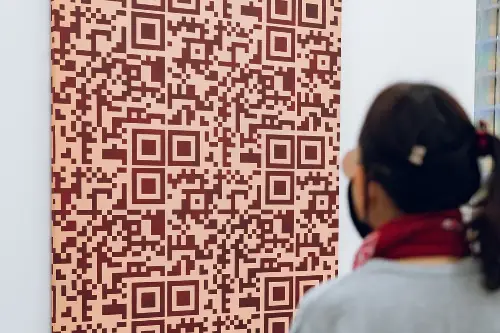
Any Singaporean who wasn’t born after 2024 should know what the work’s title refers to, but for those not in the know: SafeEntry was a national digital check-in system introduced to the island during the COVID-19 pandemic to log individuals’ visits to venues for contact-tracing purposes.
In 2019, the SAM closed for renovations whilst simultaneously employing the construction hoardings erected around its buildings as a space for art commissions. One of the two works Herman had developed for the hoardings was Safe Entry, an installation featuring the then-ubiquitous QR code pattern spanning the museum’s front façade. The pattern didn’t lead to SafeEntry at all, though–it was enlarged, repeated, and slightly distorted during the process of the work’s creation, rendering it illegible for tracking.
Instead, a separate camera-readable QR code accompanying the mural linked directly to a video of Changi Airport Terminal 2. Posted on 30 April 2020—a day before the terminal closed for renovations—the video now serves as a historical document of the airport on 16 April 2020, the 10th day of the Circuit Breaker, when international travel ground to a halt.
Part 9: Endings
Finally, we’ve reached just one of the Endings in Heman Chong’s exhibits–where, just like how we started, the only work in the room greets us with yet another delightfully long title.
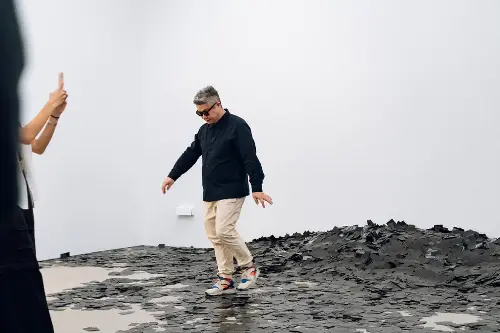
I had no way of physically confirming this, but according to its description, Monument to the people we’ve conveniently forgotten (I hate you) is one million prints of blacked-out 300-gsm name cards engulfing the exhibit floor. Once again, it’s an intended interactive work which you’re this time meant to step on–but fair warning: it’s seriously slippery, so tread not just with contempt, but also caution.
So, from the unsettling texture and subtle instability underfoot to its rant of a title, everything about this work is crafted to immerse the viewer in a quiet yet overwhelming sense of finality and the existential weight of unrealised connections. Yet, is that going to stop you from walking over it? Yeah, I thought so.
All in all, Heman Chong: This is a dynamic list and may never be able to satisfy particular standards for completeness is a vivid look into the eyes and mind of this acerbic artist.
While I think he’s addressed plenty of questions in this exhibit, it’s clear that it isn’t here to give us all the answers. Take it from the man himself, who said that in a country where we’re constantly being told what to do, he wants to move away from that paternalistic “Asian father voice” by creating a space that resists instruction and embraces ambiguity.
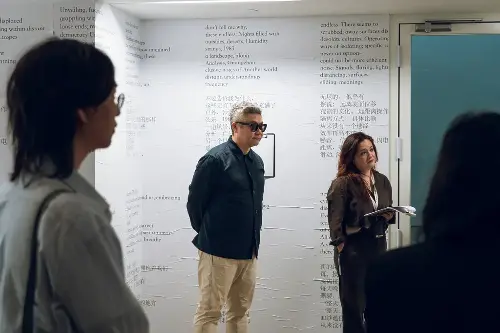
Ironically, though, he said that just before indirectly permitting us to step on the previous work by simply mentioning its possibility, but hey. Would you even have thought of doing that by yourself, too? Whatever your answer is, there’s only one place to find out–so come down to the Singapore Art Museum and pay a visit to Heman Chong’s exhibit today!
🗓Date: 10 May to 17 August 2025
📍Location: Level 1, Gallery 1, SAM at Tanjong Pagar Distripark, 39 Keppel Rd, #01-02, Singapore 089065
💲Price: Free for Singaporeans and PRs
⏰Time: 10am to 7pm
Also, this might be the first time I’ve ever seen an artist plug their own YouTube Channel in an exhibition—let alone one dedicated to them—but obviously, I respect the hustle.
So aside from smashing that Ambient Walking subscribe button, do check out the Singapore Art Museum’s website along with its socials on Instagram and TikTok for more details about this exhibit and future ones too. With that, I got some ASMR strolls to listen to, so see you at SAM.
Photos by Heng Yu Cheng of the DANAMIC Team.
